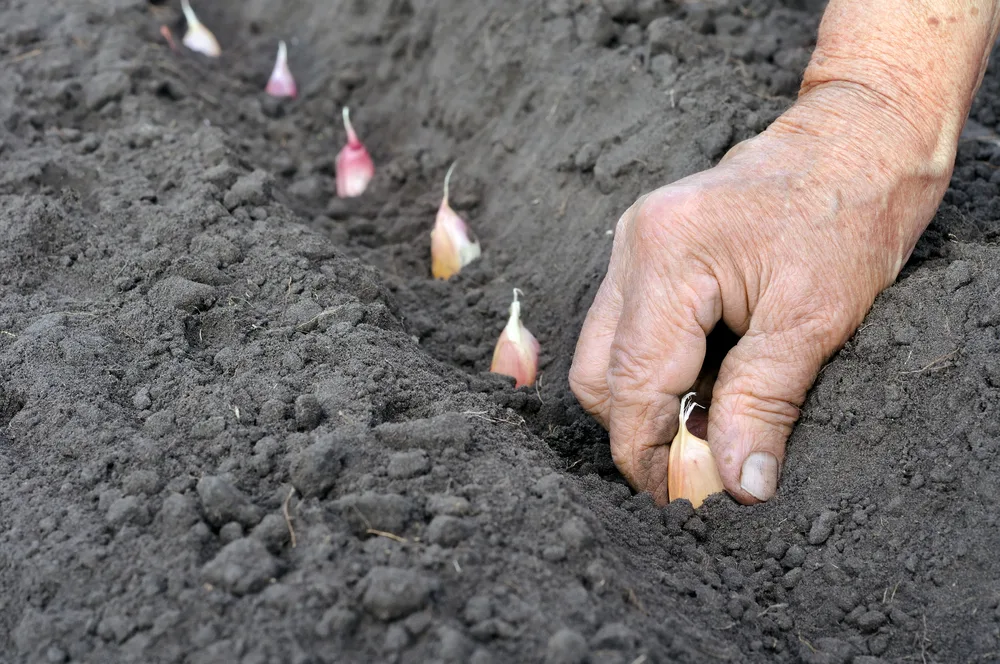
Ginger is a delicious ingredient that can be used in a wide range of recipes. It can have a range of other uses too. You may be surprised to learn just how easy it can be to grow ginger at home.
The first thing to understand about ginger is that it is a tropical plant. As such, it will not usually be possible to grow it outside in cooler temperate climates.
With a little planning and preparation, however, it is easy enough to create a growing area with the right environment. You can grow ginger fairly easily in a heated greenhouse or polytunnel structure, or on a sunny windowsill inside your home.
You may be glad to hear that no matter where you live, you do not need to be a gardening expert to grow it. And you do not need to spend much to get started.
In this article, we’ll cover how to grow ginger in a temperate climate, as well as covering some suggestions for growing ginger in a tropical or subtropical garden. So, wherever you live, you should be able to give it a go.
What is Ginger?
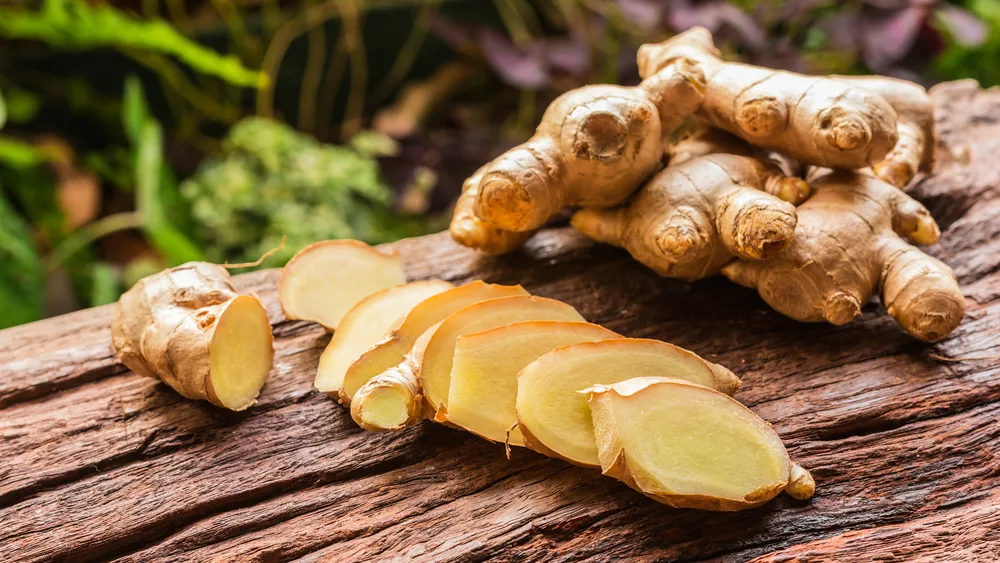
Ginger is a plant known by the Latin name Zingiber officinale. It is a perennial herb which is generally grown for its swollen underground stems, or rhizome. This is usually between 1.5 and 2.5cm thick.
The plant grows to around 30-100cm in height, and in optimal conditions can grow to form clumps of around 1.5m x 1.5m.
It forms slender pseudostems (which are also sometimes harvested for stem ginger), and has long and narrow leaves. The influorescences have pale yellow and purple flowers and grow directly from the rhizome on separate shoots. (Though these are more rarely seen in temperate climates.)
Ginger belongs to the same plant family as turmeric, cardamom and galangal. It originated in Island Southeast Asia and was likely first domesticated around 5,000 years ago by the peoples of Pacific islands during the Austronesian expansion.
This is one of the first spices to have arrived in Europe from Asia with the spice trade and is now popular around the world. The roots are used fresh and dried in a wide range of recipes. They also have a long history of medicinal use.
Today, India is the country with the highest ginger production, followed by Nigeria, China, Indonesia and Nepal. However, this is a plant that can be grown in a wide range of different areas, even in containers, which can make it ideal for small-scale home growing. Interestingly, it is only found in cultivation and never growing wild.
Why Grow Ginger?
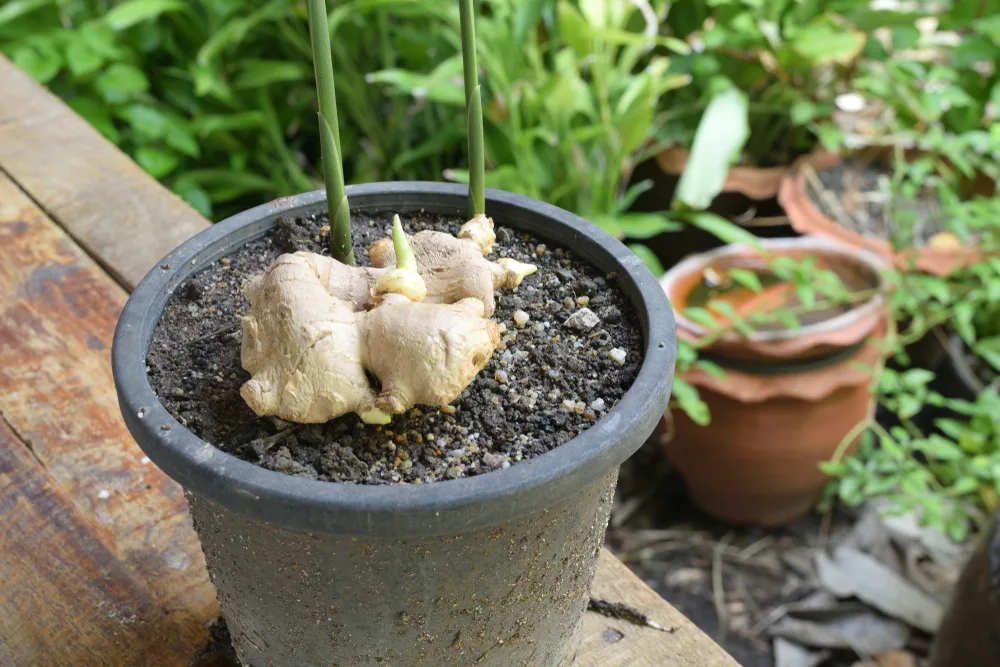
Growing your own ginger is a great way to reduce the food miles (and carbon footprint) of the food you eat. It is also an ideal crop to grow if you want to expand the range of flavours in your home-grown diet.
Ginger is not only an excellent spice for a range of curries and other recipes. It can also be used fresh and dried in a huge range of different ways. (More information on the various uses of ginger can be found towards the end of this article.)
Ginger is also a great plant to grow if you are interested in natural medicine and plants that promote good health. It is widely used in Ayurvedic and Chinese medicine and is rich in volatile oils, gingerols and (when dried) shogaols.
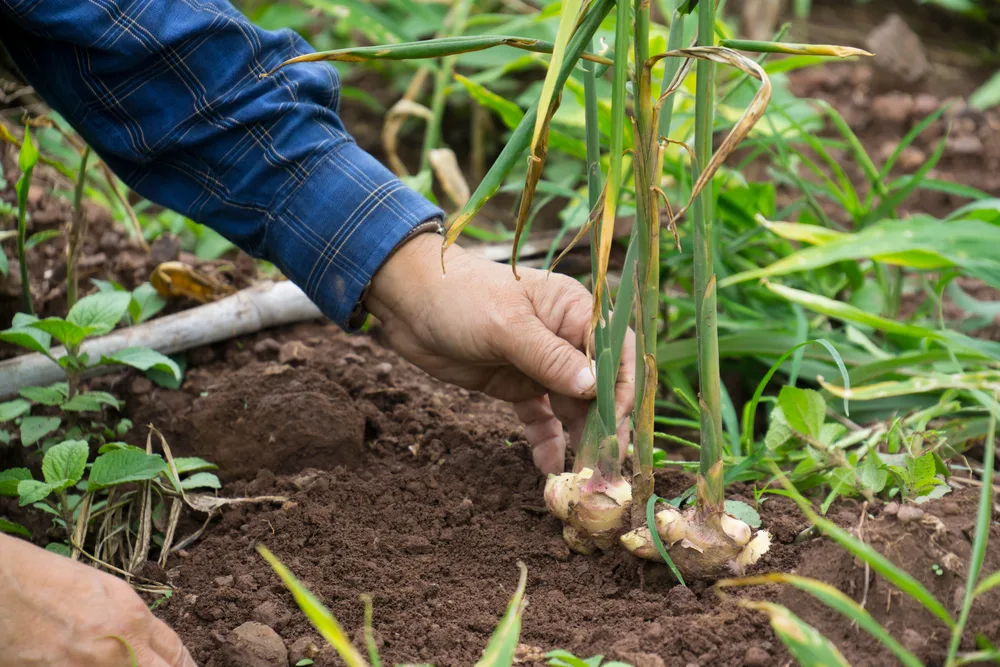
One well known use for ginger is in the control of nausea. But ginger can also be beneficial in pain relief, stimulating the circulation, treating coughs and colds, and in a number of other arenas. It is used both internally and topically.
If you are growing ginger in a temperate climate, it can be grown in a container and so can take up little space. So it is easy to find space for some on a sunny windowsill or another small, warm and light location.
If you are growing ginger in the ground, either in an undercover growing area or outside in a tropical or subtropical garden, ginger can also work well in tropical or sub-tropical polycultures. Ideas on plants to grow alongside ginger in such a garden can be found in the ‘planting your ginger’ section below.
Sourcing Ginger For Planting
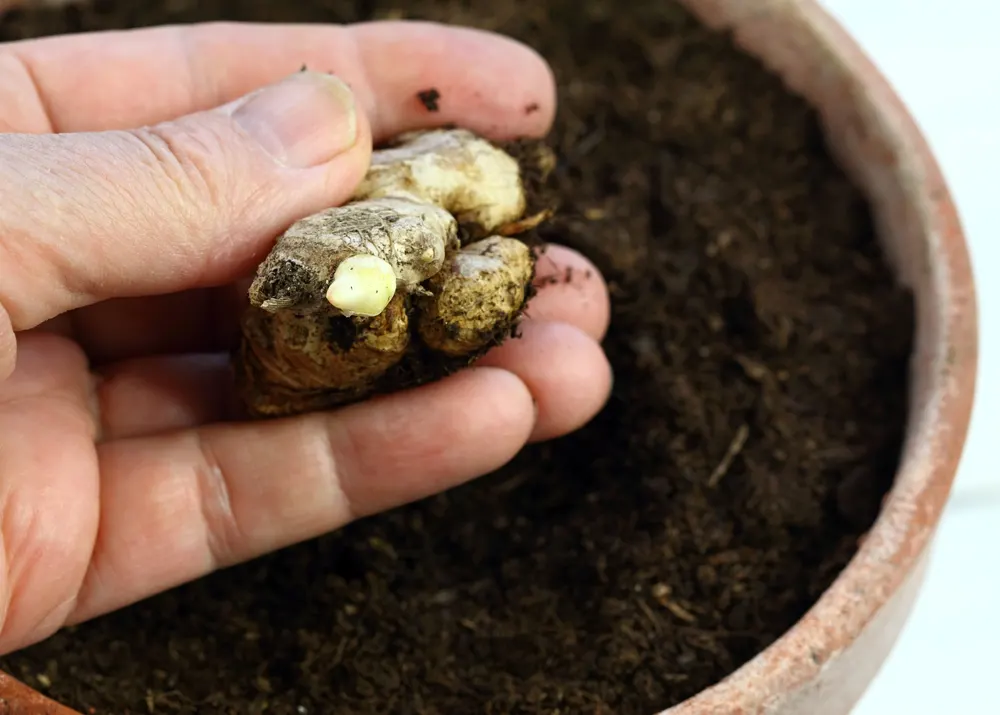
Ginger can be sourced online or perhaps from a plant nursery nearby.
This well reviewed Amazon listing sells 10 ginger roots that are ideal for planting and growing.
If you are having trouble sourcing ginger rhizomes to plant, however, you could consider planting ginger that you have bought in the shops.
Related Reading: 20 Foods You Can Regrow From Scraps
It is important to note that some ginger will have been treated to prevent shoots from forming. So you may not always have success with this method. (Soaking the root in water for 24 hours may help by washing away any growth retardant that has been used.)
If the ginger root you have bought develops green growth, however, it is definitely worthwhile giving it a go. Note: the larger the rhizome the faster the ginger will be produced.
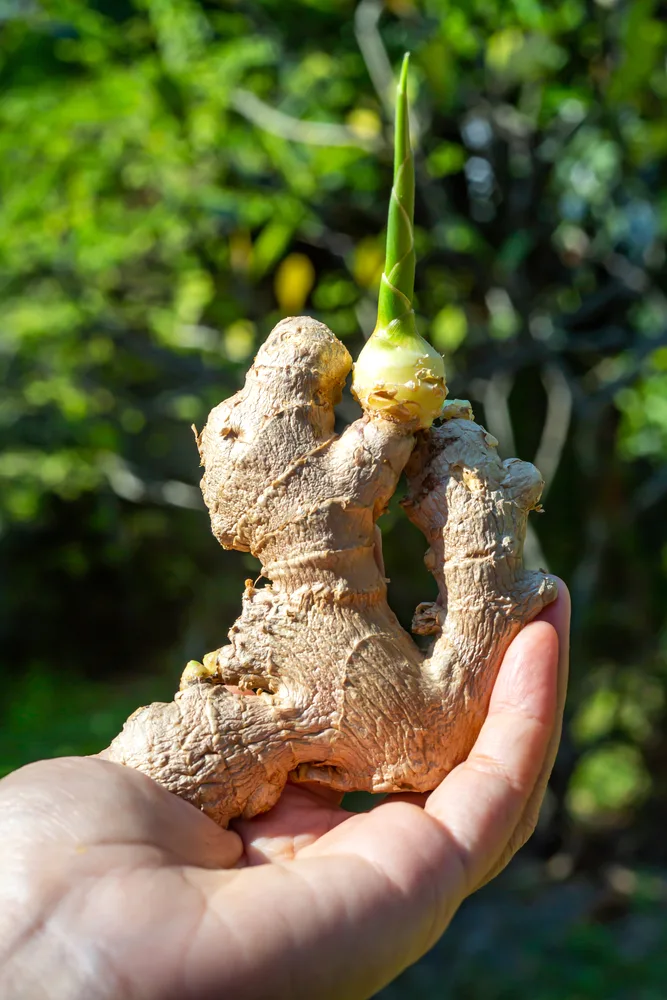
Look for a rhizome (root section) with small nodules similar to the chits that appear on potatoes. It is from these small growth buds that your ginger plant will grow.
Choosing Where To Grow Ginger
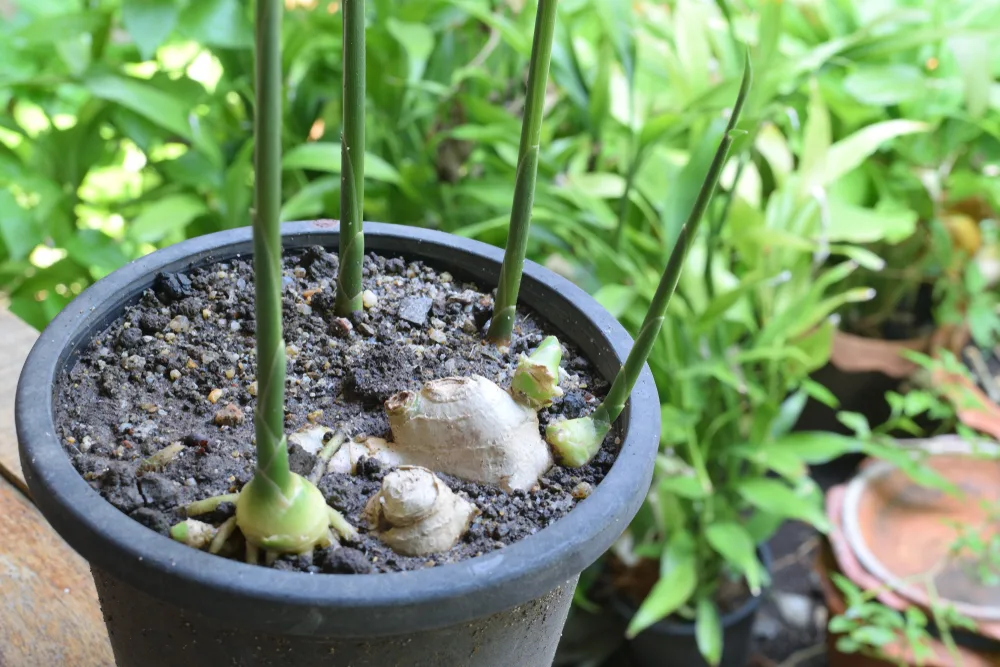
Before you plant your ginger, of course, you will have to decide where to grow it. In large part, the best location will depend on your climate zone, and the conditions where you live.
Naturally a plant found in moist to wet tropics, where it is found at elevations up to 1,900m, ginger is best grown where daytime temperatures can be maintained at between 65 and 85 degrees F. However, it can cope with temperatures between 55 and 95 degrees F. Try to grow ginger at temperatures lower than this, though, and dormancy can be induced.
The ideal annual rainfall range for ginger plants is between 1,400 and 3,000 mm, though it can cope with rainfall between 400 mm and 4,000mm. If you are growing your ginger inside or under cover, obviously you will have to ensure through your own watering efforts that the right amount of water is delivered.
Ginger grows best in a well-drained, humus-rich, neutral to alkaline soil. Ideally, the pH of the soil or growing medium should be between 6-7. It should be planted in a position with full sun in cooler more northerly climes, though it can tolerate partial shade, and may prefer a partially shaded spot in hotter regions.
Planting Ginger
A good time to begin planting ginger in temperate climates is the end of winter. However, if you intend to keep your ginger indoors all year round then you can give this process a go any any time.
Simply choose a suitable growing medium (moist and humus-rich yet free-draining) and plant your ginger into this mix. It may be beneficial to allow the budding root sections to dry out before planting, to heal their wounds.
Plant root sections with green growth buds just protruding above the surface of the soil. You can plant into a seed tray and pot up when it begins to grow, or simply plant the ginger into the container you intend to keep it in.
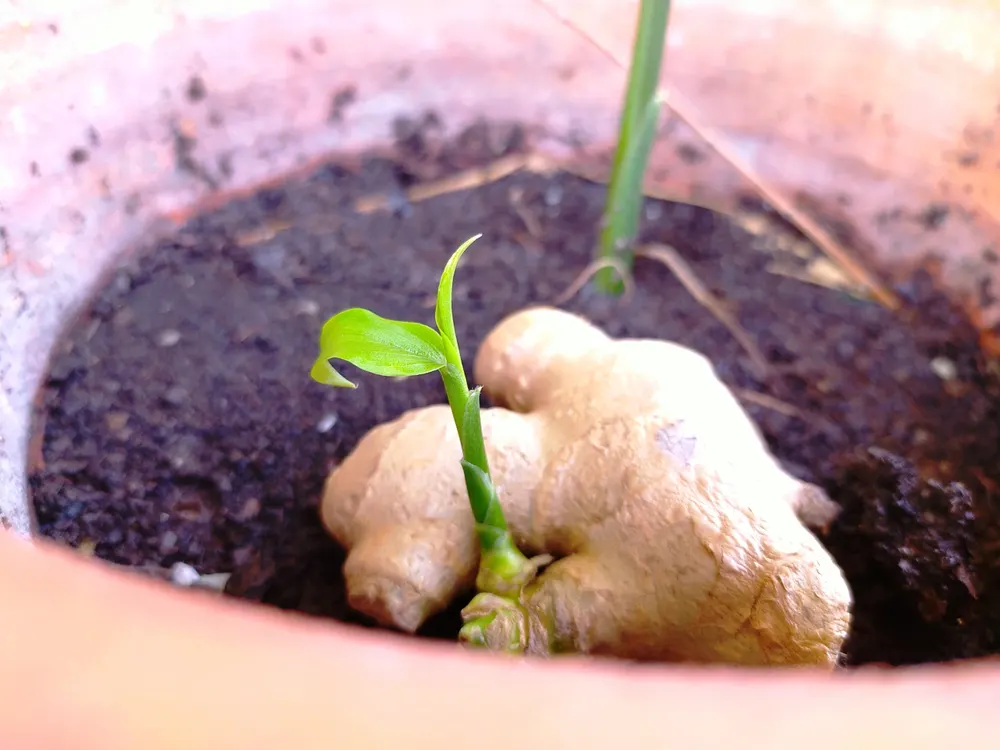
Bottom heat may be beneficial and so you could consider placing your tray or container on a heat mat or in a heated propagator. However, providing it is warm enough, the ginger will usually take on a sunny windowsill.
When choosing containers for ginger, remember that this is a crop that you are growing primarily for the root. Tall, narrow pots are best as these will allow the fat roots to grow and delve deep as the buds start to grow.
Planting Ginger in a Warmer Climate
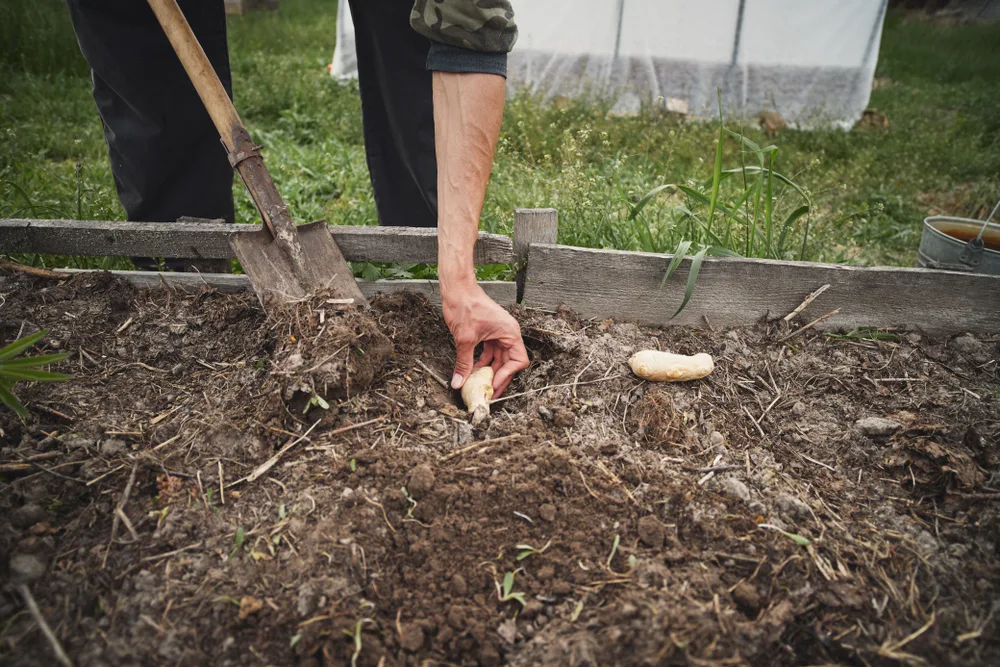
If you are in a warmer, subtropical or tropical climate, you can simply place your rhizomes into the soil where they are to grow. Ginger can be an excellent choice for inclusion in a forest garden scheme, tree circle, or other tropical polyculture.
In a subtropical or tropical forest garden, or a fruit or nut tree circle, ginger can thrive in the dappled shade beneath your trees. If you are using the permaculture concept of a tree circle (such as a banana circle, for example) ginger and taro can be excellent plant choices for the inner, wetter edge of the ring mound on which the trees are planted.
Related turmeric, cardamom and galangal can all be good companions for your ginger plants. Ginger will thrive amid natural, native companions in moist, tropical settings. Natural companions include hibiscus, teak, palms, and orchids.
Caring For Your Ginger
Ginger plants require relatively high humidity. (Bear in mind that these plants naturally grow in a tropical rainforest.) This can be one of the major challenges when growing ginger indoors in a temperate climate.
Indoors heating, especially central heating, can really dry out the air. So it will usually be necessary, in addition to watering your ginger, to spray the plants leaves regularly to increase humidity levels around your plant or plants. Be sure to water well but do not overwater and make sure the containers and growing medium you use are free-draining.
If possible, it would be ideal to grow your ginger in a higher humidity environment. For example, in your kitchen close to a kitchen sink, or in a light, bright bathroom.
As your ginger plant grows, pot it up regularly. By mid-summer, if your plant is thriving, it should be in a rather large container – perhaps even something like a 5 gallon bucket.
Caring For Ginger in a Warmer Climate
Outdoors, in a tropical or subtropical setting, ginger should be low maintenance in the right environment. You can largely simply leave it to its own devices and let nature take its course.
Growing ginger in a tree circle is ideal, because all the elements of the polyculture will work together to create a resilient ecosystem. In such a scheme, organic matter and water are added to a pit at the centre of the ring, so the system is fed with a consistent supply of nutrients and moisture.
Harvesting Ginger
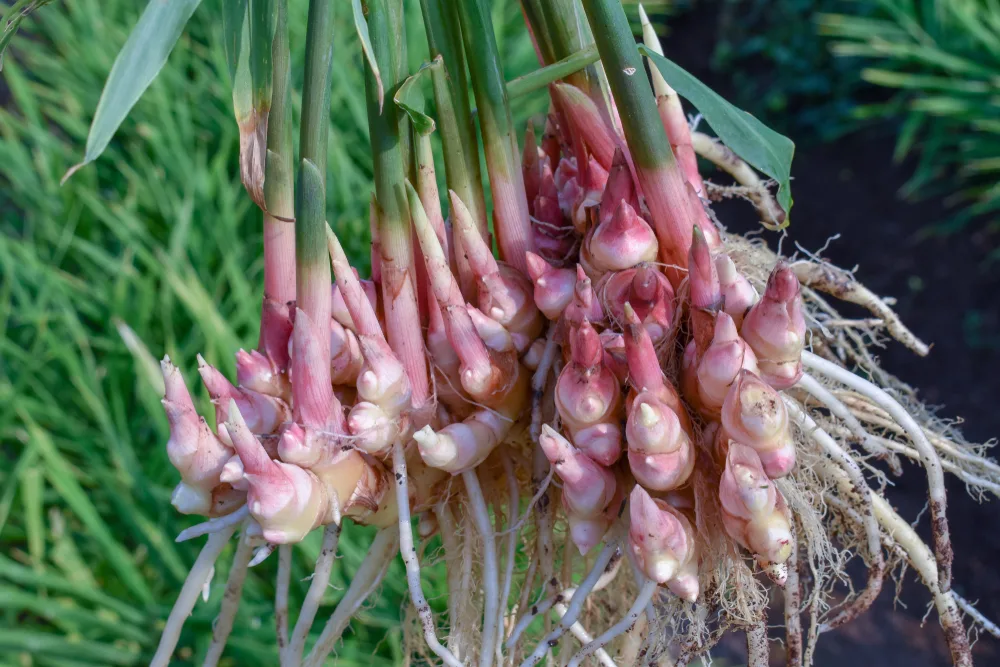
Ginger, when provided with the right ingredients for good growth, should be fully mature and ready to harvest in approximately ten months.
If you wish, you can start to harvest ginger from around four months after planting. You can carefully cut away a small portion of your plant and root, leaving the rest to grow. However, it is important to note that this green ginger does not have the same taste as ginger that is fully mature.
By autumn, in temperate climate areas, you should also have the option of harvesting small quantities of stem ginger. One of the advantages of growing your own ginger is that you will be able to get your hands on stem ginger. That is often more difficult to find in such climate zones than the root ginger you will be more familiar with.
Stem bases can swell to around golf ball size. These can be cut off and candied to make sweets. They can also be used in a number of other ways.
The main harvest time, however, will come when the plant is fully mature. After eight to ten months, the foliage will begin to die down. After leaf drop is the perfect time to harvest. Unearth the roots and you should discover that a new ‘hand’ of root ginger has grown.
Be sure to set aside some good budging sections for next year. Whatever else is left, you can make use of in a range of different ways in your kitchen and around your home.
Using Your Ginger
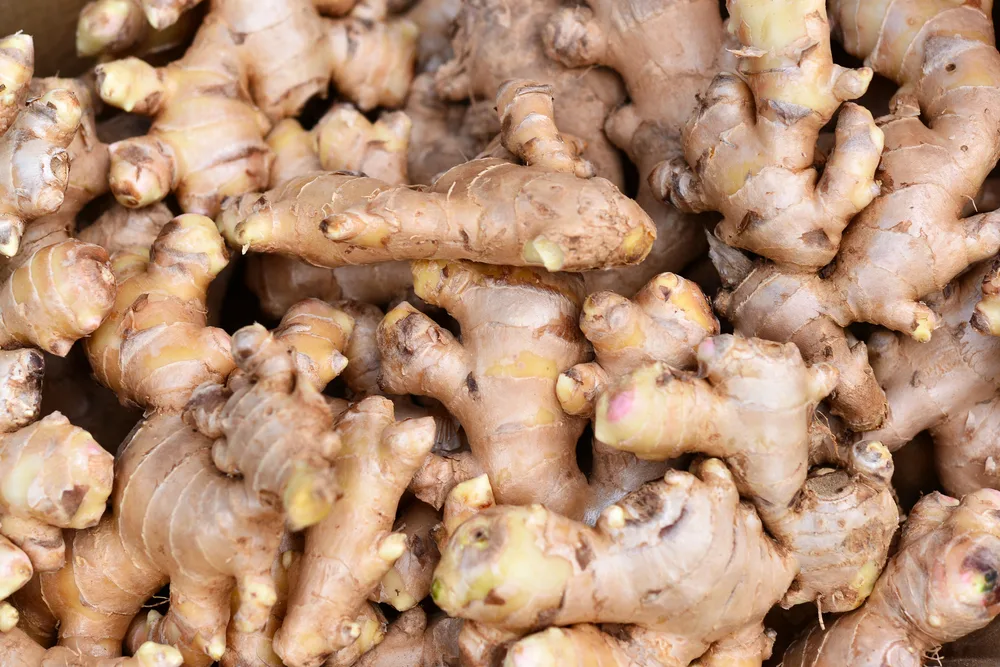
Ginger root can be used fresh, dried, or otherwise preserved for later use. You should have no difficulty finding plenty of exciting ginger recipes to try.
Fresh Ginger Recipes
Ginger is an ingredient that can work very well both in savoury and sweet recipes. Here are a few excellent recipes you could consider:
Vegan Thai Green Curry @ lazycatkitchen.com.
Red Thai Curry With Vegetables @ cookieandkate.com
Carrot and Ginger Soup @ bbcgoodfood.com.
Moroccan Vegetable Stew @ yupitsvegan.com
Gingery Maple Glazed Tempeh on Baby Greens Salad @ onegreenplanet.org.
And if you are looking for something sweet, how about:
Spicy Gingerbread Cake @ onegreenplanet.org.
Fresh Ginger Cookies @ allrecipes.com.
Vegan Gingersnap Cookies @ lovingitvegan.com.
Lemon and Ginger Energy Bars @ everydaycookingwithmira.com.
Ginger Sticky Toffee Pudding @ livekindly.co.
Ginger Drink Recipes
Dad’s Traditional Switchel Recipe @ Rural Sprout
Turmeric Gingerade @ Feasting At Home
Drying Ginger
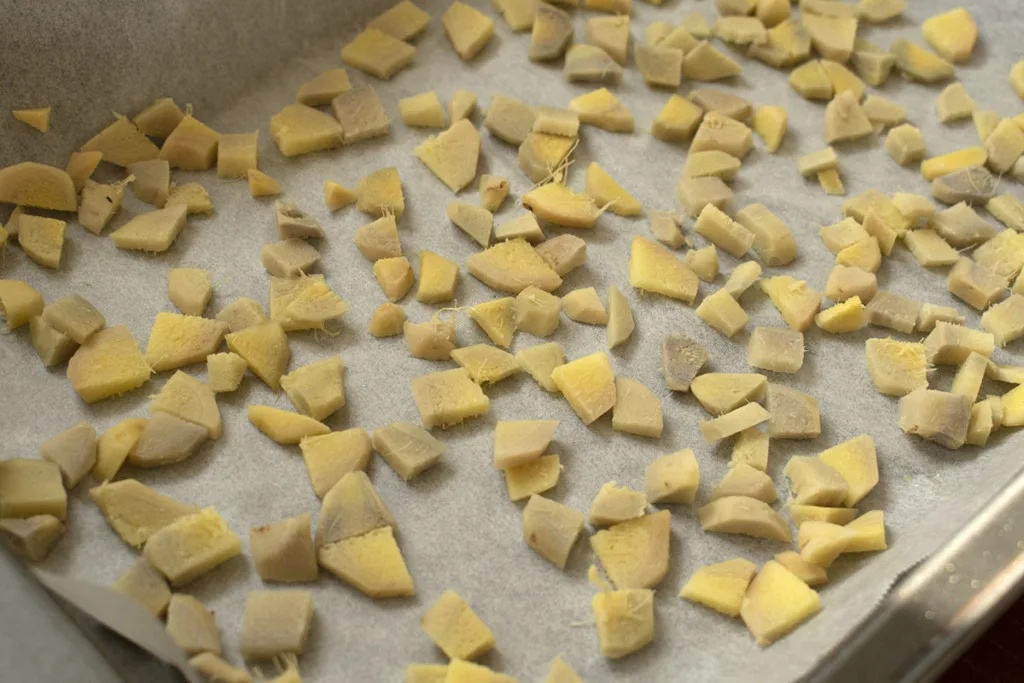
If you do not want to use up all your ginger right away, one way to make it last is to dry it. Drying your ginger will allow you to keep it for longer. It will also increase its fragrance and potency as a spice.
To dry your ginger, you can simply leave it on a dry and sunny windowsill for a few days in warmer, drier areas. But air drying may be a challenge in a cooler and more humid climate. You can use a dehydrator if you have one. (Drying time in a dehydrator will depend on the heat setting).
If you do not have a dehydrator, you can dry your ginger in your oven.
To speed up the drying time, peel the root, and slice your root ginger as finely as possible. Spread out the ginger slices on a rack or oven tray. In your oven, drying thin slices (at no higher than 150F) will take around 1 ½ to 2 hours. Check your ginger every half an hour or so to make sure it does not burn.
It is important to make sure that the ginger slices are completely dry before you store them, or grind them into powder. Any residual moisture could allow mold.
Once your ginger slices are completely dry, you can simply store these. They should be good in an airtight container for around 5-6 months. Dried slices like this can be great for making ginger tea.
Grinding Dried Ginger
You can also now grind your dried ginger into powder. A coffee grinder or spice grinder can be used to create a fine powder. If you do not have one, you could also expend more effort and grind your ginger manually with a mortar and pestle.
Ground ginger will be good in an airtight container for a couple of months. But you can also store it in an airtight container in your freezer if you want to make a larger batch. In the freezer it will last much longer.
Read Next: How To Make Powdered Ginger – Step-by-Step with Photos
Ginger Preserves
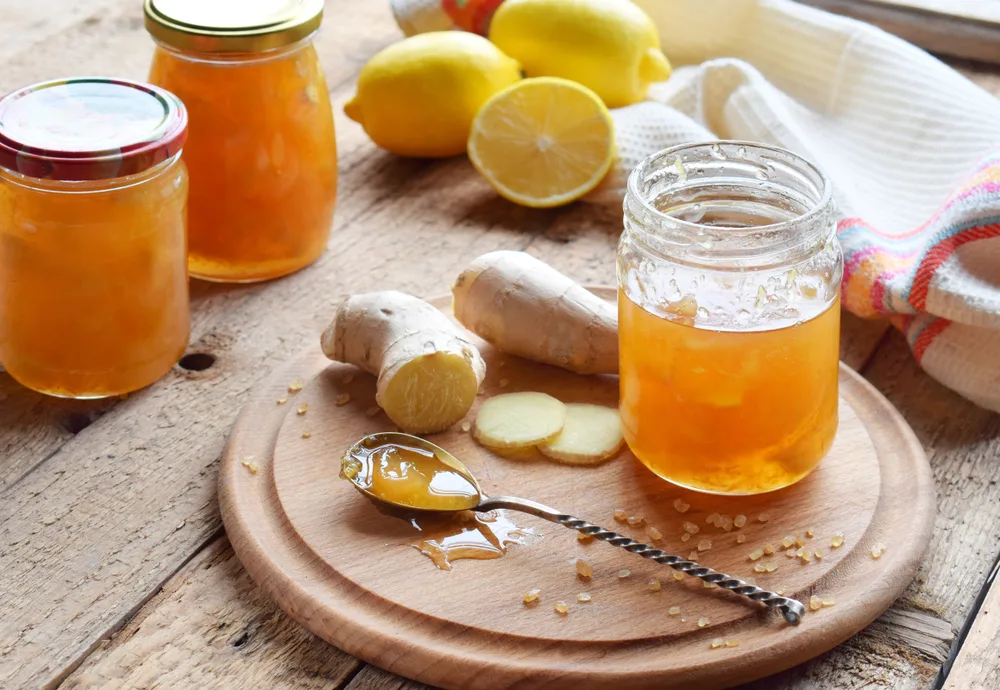
You could also make your fresh ginger last longer by turning it into a range of different preserves. Here are a few examples of recipes you could try:
Ginger Marmalade @ allrecipes.com.
Rhubarb and Ginger Jam @ bbcgoodfood.com.
Apple Ginger Chutney @ allrecipes.com.
Gari: Japanese Pickled Ginger @ thespruceeats.com.
Heritage Carrot and Ginger Pickle @ thehappyfoodie.co.uk.
Other Uses For Ginger
Ginger cannot only be used for culinary purposes. It also has a wide range of other uses. For example, you could juice ginger for its health giving benefits, then use the fresh pulp to make soap.
Ginger Soap @ lovinsoap.com.
And that is just one of many ways you could incorporate ginger in your skincare and beauty regime. You’ll find more suggestions by following the link below:
Ways To Use Ginger as a Beauty Product @ youbeauty.com.
And these are still only a small number of the many uses for this very useful plant. So, whether you live in the tropics, or in a much grayer and colder environment, why not give growing ginger a go?
Read Next:

Get the famous Rural Sprout newsletter delivered to your inbox.
Including Sunday ramblings from our editor, Tracey, as well as “What’s Up Wednesday” our roundup of what’s in season and new article updates and alerts.



